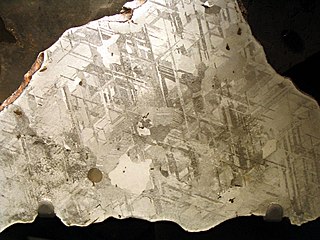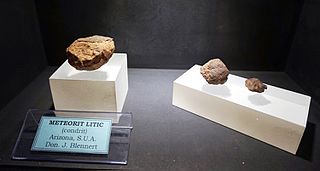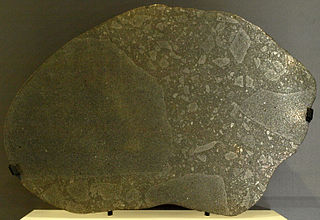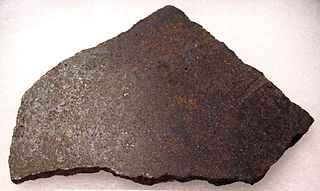Related Research Articles

Kamacite is an alloy of iron and nickel, which is found on Earth only in meteorites. According to the International Mineralogical Association (IMA) it is considered a proper nickel-rich variety of the mineral native iron. The proportion iron:nickel is between 90%:10% and 95%:5%; small quantities of other elements, such as cobalt or carbon may also be present. The mineral has a metallic luster, is gray and has no clear cleavage although its crystal structure is isometric-hexoctahedral. Its density is about 8 g/cm3 and its hardness is 4 on the Mohs scale. It is also sometimes called balkeneisen.

In meteoritics, a meteorite classification system attempts to group similar meteorites and allows scientists to communicate with a standardized terminology when discussing them. Meteorites are classified according to a variety of characteristics, especially mineralogical, petrological, chemical, and isotopic properties.

A chondrule is a round grain found in a chondrite. Chondrules form as molten or partially molten droplets in space before being accreted to their parent asteroids. Because chondrites represent one of the oldest solid materials within the Solar System and are believed to be the building blocks of the planetary system, it follows that an understanding of the formation of chondrules is important to understand the initial development of the planetary system.

A chondrite is a stony (non-metallic) meteorite that has not been modified, by either melting or differentiation of the parent body. They are formed when various types of dust and small grains in the early Solar System accreted to form primitive asteroids. Some such bodies that are captured in the planet's gravity well become the most common type of meteorite by arriving on a trajectory toward the planet's surface. Estimates for their contribution to the total meteorite population vary between 85.7% and 86.2%.

The H type ordinary chondrites are the most common type of meteorite, accounting for approximately 40% of all those catalogued, 46% of the ordinary chondrites, and 44% of all chondrites. The ordinary chondrites are thought to have originated from three parent asteroids, whose fragments make up the H chondrite, L chondrite and LL chondrite groups respectively.

The ordinary chondrites are a class of stony chondritic meteorites. They are by far the most numerous group, comprising 87% of all finds. Hence, they have been dubbed "ordinary". The ordinary chondrites are thought to have originated from three parent asteroids, with the fragments making up the H chondrite, L chondrite and LL chondrite groups respectively.

The L type ordinary chondrites are the second most common group of meteorites, accounting for approximately 35% of all those catalogued, and 40% of the ordinary chondrites. The ordinary chondrites are thought to have originated from three parent asteroids, with the fragments making up the H chondrite, L chondrite and LL chondrite groups respectively.

The LL chondrites are a group of stony meteorites, the least abundant group of the ordinary chondrites, accounting for about 10–11% of observed ordinary-chondrite falls and 8–9% of all meteorite falls. The ordinary chondrites are thought to have originated from three parent asteroids, with the fragments making up the H chondrite, L chondrite and LL chondrite groups respectively. The composition of the Chelyabinsk meteorite is that of a LL chondrite meteorite. The material makeup of Itokawa, the asteroid visited by the Hayabusa spacecraft which landed on it and brought particles back to Earth also proved to be type LL chondrite.

Homestead is a L5 meteorite fallen in 1875 in Iowa, United States.

Gao–Guenie is a H5 ordinary chondrite meteorite that fell on Burkina Faso, West Africa, on March 5, 1960. The fall was composed of many fragments and it is one of the largest observed meteorite showers in Africa to date.

Enstatite chondrites are a rare form of meteorite, rich in the mineral enstatite. Only about 200 E-Type chondrites are currently known, comprising about 2% of the chondrites that fall on Earth. There are two main subtypes: EH and EL, classified based on their iron content.
Archie is an H chondrite meteorite that fell to earth on August 10, 1932, in Archie, Missouri.

Allegan is a type 5 H chondrite meteorite that landed west of Allegan, Michigan on July 10, 1899. Allegan weighed around fifty pounds after its landing. As of 1964, it was one of only seven known meteorites to land in Michigan.

Arroyo Aguiar is an H chondrite meteorite that fell to earth during the summer of 1950 in the province of Santa Fe, Argentina.
Assisi is an H chondrite meteorite that fell to earth at 7:00 am on May 24, 1886, in Perugia, Umbria, Italy.
CI chondrites, also called C1 chondrites or Ivuna-type carbonaceous chondrites, are a group of rare carbonaceous chondrite, a type of stony meteorite. They are named after the Ivuna meteorite, the type specimen. CI chondrites have been recovered in France, Canada, India, and Tanzania. Their overall chemical composition closely resembles the elemental composition of the Sun, more so than any other type of meteorite.
Claxton is an L6 chondrite meteorite that fell to earth on December 10, 1984 in Georgia, United States. It is the only known meteorite to directly strike a mailbox.
This is a glossary of terms used in meteoritics, the science of meteorites.

The Ordovician meteor event was a dramatic increase in the rate at which L chondrite meteorites fell to Earth during the Middle Ordovician period, about 467.5±0.28 million years ago. This is indicated by abundant fossil L chondrite meteorites in a quarry in Sweden and enhanced concentrations of ordinary chondritic chromite grains in sedimentary rocks from this time.
CM chondrites are a group of chondritic meteorites which resemble their type specimen, the Mighei meteorite. The CM is the most commonly recovered group of the 'carbonaceous chondrite' class of meteorites, though all are rarer in collections than ordinary chondrites.
References
- 1 2 Meteoritical Bulletin Database: Agen
- ↑ Taricco, C.; Sinha, N.; Bhandari, N.; Colombetti, P.; Mancuso, S.; Rubinetti, S.; Barghini, D. (2016-09-26). "Early 18th century cosmic ray flux inferred from 44Ti in Agen meteorite". Astrophysics and Space Science. 361 (10): 338. Bibcode:2016Ap&SS.361..338T. doi:10.1007/s10509-016-2909-7. hdl: 2318/1610590 . ISSN 1572-946X.